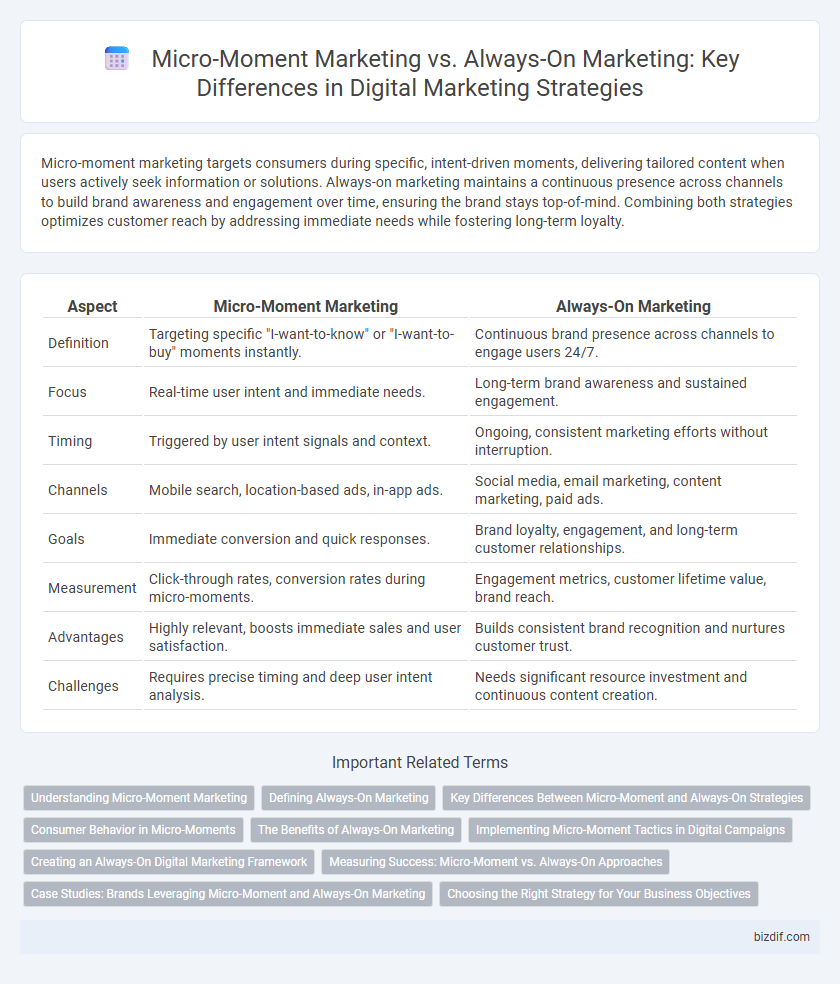Micro-moment marketing targets consumers during specific, intent-driven moments, delivering tailored content when users actively seek information or solutions. Always-on marketing maintains a continuous presence across channels to build brand awareness and engagement over time, ensuring the brand stays top-of-mind. Combining both strategies optimizes customer reach by addressing immediate needs while fostering long-term loyalty.
Table of Comparison
| Aspect | Micro-Moment Marketing | Always-On Marketing |
|---|---|---|
| Definition | Targeting specific "I-want-to-know" or "I-want-to-buy" moments instantly. | Continuous brand presence across channels to engage users 24/7. |
| Focus | Real-time user intent and immediate needs. | Long-term brand awareness and sustained engagement. |
| Timing | Triggered by user intent signals and context. | Ongoing, consistent marketing efforts without interruption. |
| Channels | Mobile search, location-based ads, in-app ads. | Social media, email marketing, content marketing, paid ads. |
| Goals | Immediate conversion and quick responses. | Brand loyalty, engagement, and long-term customer relationships. |
| Measurement | Click-through rates, conversion rates during micro-moments. | Engagement metrics, customer lifetime value, brand reach. |
| Advantages | Highly relevant, boosts immediate sales and user satisfaction. | Builds consistent brand recognition and nurtures customer trust. |
| Challenges | Requires precise timing and deep user intent analysis. | Needs significant resource investment and continuous content creation. |
Understanding Micro-Moment Marketing
Micro-moment marketing targets specific, intent-driven instances when consumers turn to their devices for immediate answers, emphasizing real-time relevance and personalization. It leverages data on consumer behavior to deliver timely, context-specific content that meets users' needs precisely when they arise. This approach contrasts with always-on marketing by focusing on capturing intent in brief, high-impact interactions rather than continuously maintaining brand presence.
Defining Always-On Marketing
Always-on marketing is a continuous digital marketing strategy that maintains constant engagement with the target audience through multiple channels such as social media, email, and content marketing. This approach leverages real-time data and automated tools to deliver personalized, relevant messages, ensuring brands remain top-of-mind throughout the customer journey. Unlike micro-moment marketing, which targets specific intent-driven moments, always-on marketing builds long-term brand awareness and customer loyalty through persistent online presence.
Key Differences Between Micro-Moment and Always-On Strategies
Micro-moment marketing targets specific, intent-driven consumer interactions occurring in real-time, leveraging immediate needs like "I want to buy" or "I want to know" moments to deliver highly relevant content. Always-on marketing maintains continuous engagement with the audience by consistently publishing content and campaigns across channels, building long-term brand awareness and loyalty. The key difference lies in micro-moments' focus on immediacy and context-specific triggers versus always-on strategies' emphasis on sustained presence and broad audience reach.
Consumer Behavior in Micro-Moments
Micro-moment marketing targets specific, intent-driven consumer behaviors by delivering timely, relevant content precisely when users seek immediate answers or solutions. This strategy captures decision-making instances during spontaneous searches, influencing purchasing choices through contextual relevance and real-time engagement. In contrast, always-on marketing maintains continuous brand presence but lacks the immediacy and personalized interaction characteristic of micro-moment marketing's focus on dynamic consumer intent.
The Benefits of Always-On Marketing
Always-on marketing ensures continuous engagement with audiences by delivering timely, personalized content across multiple digital channels, increasing brand recall and customer loyalty. This strategy leverages real-time data analytics to optimize campaigns dynamically, resulting in higher conversion rates and more efficient budget allocation. Consistent presence enhances SEO performance and strengthens brand authority, making always-on marketing a critical approach in the fast-paced digital landscape.
Implementing Micro-Moment Tactics in Digital Campaigns
Implementing micro-moment tactics in digital campaigns targets precise consumer needs by delivering timely, contextually relevant content during critical decision-making moments. Utilizing real-time data and location-based triggers enhances user engagement by addressing immediate intent, contrasting with the continuous, broad-reaching approach of always-on marketing. Leveraging micro-moments boosts conversion rates through hyper-personalized interactions that align marketing efforts with specific consumer behaviors and preferences.
Creating an Always-On Digital Marketing Framework
Creating an always-on digital marketing framework ensures continuous engagement by delivering timely, relevant content that captures consumer intent during micro-moments. Unlike micro-moment marketing, which targets specific decision points, an always-on strategy maintains consistent brand presence across multiple channels, leveraging data analytics and automation to optimize performance around the clock. This approach enhances customer journey tracking, boosts brand recall, and drives sustained conversions by addressing evolving consumer needs in real time.
Measuring Success: Micro-Moment vs. Always-On Approaches
Micro-moment marketing success is measured by real-time engagement metrics such as click-through rates, immediate conversions, and moment-to-moment interactions, reflecting user intent at specific instances. Always-on marketing effectiveness relies on long-term performance indicators like brand awareness growth, customer lifetime value, and steady traffic or lead generation over time. Comparing these approaches reveals that micro-moment campaigns excel in capturing urgent consumer actions, while always-on strategies build sustained brand presence and loyalty.
Case Studies: Brands Leveraging Micro-Moment and Always-On Marketing
Brands like Nike and Starbucks exemplify micro-moment marketing by delivering personalized, context-driven content during key consumer decision points, resulting in increased engagement and immediate conversions. Coca-Cola and Amazon effectively utilize always-on marketing strategies, sustaining continuous digital presence through persistent social media and content campaigns that build brand loyalty over time. Case studies reveal that combining micro-moment precision with always-on consistency maximizes reach and drives both instant actions and long-term brand affinity.
Choosing the Right Strategy for Your Business Objectives
Micro-moment marketing targets specific intent-driven interactions, delivering timely, relevant content that captures consumer attention during critical decision-making instances. Always-on marketing maintains continuous engagement through consistent messaging across multiple channels, building brand awareness and long-term customer loyalty. Aligning these strategies with business objectives involves assessing whether immediate conversion opportunities or sustained audience interaction better support goals such as lead generation, brand growth, or customer retention.
Micro-moment marketing vs Always-on marketing Infographic

 bizdif.com
bizdif.com